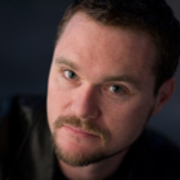
James Cunningham
James Cunningham believes that although animation is ultimately just a tool, it can be a very powerful tool — the kind that allows filmmakers the ability to craft exactly the images and angles that they want to realise their vision.
Cunningham’s own career has seen him specialising in computer-generated imagery, be it full 3D animation or visual effects added to live action. Since graduating from Elam (in Auckland) in 1997, he has crossed back and forth between the stylised CGI images found in his own shorts, and the photo-realistic kind used in live action commercials and movies.
“When partnered with strong stories and great acting,” argues Cunningham, “the medium of computer generated imagery opens up possibilities in telling stories that might otherwise be too difficult or not possible at all. I’d like to push those boundaries.”
Cunningham studied photography at Elam, following it with a Master of Fine Arts in digital animation. In 1997, working alongside producing partner Paul Swadel, he completed rollercoaster-style short film Delf (short for ‘digitally engineered life forms’). The film featured two tadpole-like creatures on the chase, set to a driving Pitch Black soundtrack. Delf — and follow-up films Blinder (1998) and 14-months in the making Infection (2000) — all starred computer programmes as on-screen characters, moving through their own digital worlds.
Delf and Blinder both won attention — Blinder even got local theatrical release alongside movie In the Company of Men. But Infection proved to be Cunningham’s international breakthrough. Peopled with a troupe of syringe-soldiers and the Dali-like moving eyeball seen in Blinder, Infection became one of the biggest selling-Kiwi shorts to date. Alongside invitations to 20+ festivals, the stylish tale of digital robbery competed at Cannes in 2000, plus indie showcase Sundance.
By now Cunningham had joined the Weta Digital crew in Wellington, as a shot-lighting technical director on the first episode of The Lord of The Rings. He went on to take up a position as Head of 3D at Auckland post-production house Digital Post, where for four years he led a team providing digital effects for a range of television commercials, plus feature comedy The Devil Dared Me To.
When Cunningham heard the pitch for Poppy, a tale of WWI soldiers from talented young writer David Coyle, he felt strongly that it would gain added power as an animated film. Months later, Cunningham and film-making partner Paul Swadel began rehearsing with actors Paul Glover and Matthew Sunderland, using umbrellas and golf-clubs filling in for rifles. Later they captured footage of the actors during an extended day of motion capture at Weta Digital.
As Swadel put it, Cunningham’s desire was to use CGI “to pare everything back to a desolate landscape, to focus right in close on our two main characters, and allow the actors to lead.” For Cunningham, Poppy was the chance to make a serious performance-driven CGI animated film for adults — one “with the emotional power to move an audience”.
Cunningham spent 14 months making Poppy, aided by a small support team that grew from one to three artists across the year. In total it took 4,500 hours to produce the 10 minutes of animated film. The result was two awards at international computer graphics conference Siggraph, a ‘Best Technical Contribution’ Award back home, and invites to a run of festivals, including Melbourne, SXSW and Telluride.
Cunningham continues to be involved in animated shorts as teacher of the 3D animation course at Auckland’s Media Design School. Among his goals is making sure the work of students wins international recognition. Led by Cunningham, two shorts from the Advanced 3D production class were finalists at the 2010 Visual Effects Society awards: Time for Change, and submarine tale Das Tub (Time for Change and sci-fi spoof First Contact were also selected for premier CGI showcase SIGGRAPH). Das Tub also went on to win Best Short Short at the 2011 Aspen Shortsfest, and Cunningham took Best Director at the Honolulu Film Awards.
Next came The Deadliest Game, a colonial-styled alien encounter tale based on the Dr Grordbort universe first created by Weta designer Greg Broadmore. Broadmore collaborated with media design students again, when he helped corral the robot stars of slacker comedy Shelved. The film won animation gongs at the 2013 Los Angeles Movie Awards.
In 2015 possum tale Accidents, Blunders and Calamities was invited to compete at Clermont-Ferrand in France, home to arguably the most prestigious short film festival on the globe.
Cunningham/The Design School's zombie romcom Rotting Hill (2011) has been viewed more than a million times on website Vimeo.
Cunningham and Paul Swadel are developing their ambitious CGI feature Marshal, working with ex New Line/Lord of the Rings executive Mark Ordesky.
Sources include
James Cunningham
Media Design School website. Accessed 26 January 2021
'Digital Filmmaking: Poppy art' (Interview with James Cunningham and Paul Swadel) - Onfilm, July 2009
Poppy website (broken link). Accessed 7 December 2015
Poppy press kit